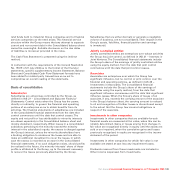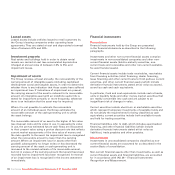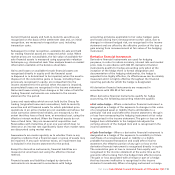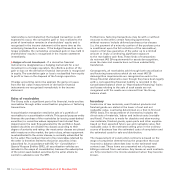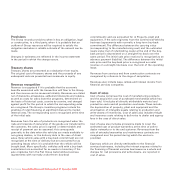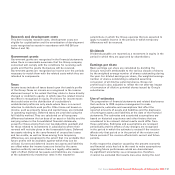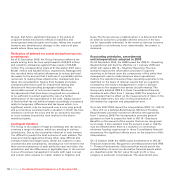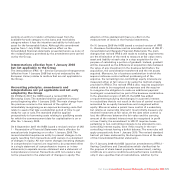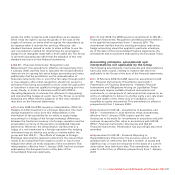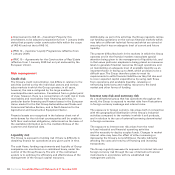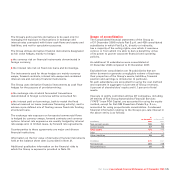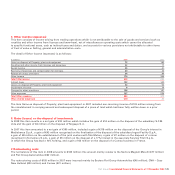Chrysler 2008 Annual Report Download - page 120
Download and view the complete annual report
Please find page 120 of the 2008 Chrysler annual report below. You can navigate through the pages in the report by either clicking on the pages listed below, or by using the keyword search tool below to find specific information within the annual report.Fiat Group Consolidated Financial Statements at 31 December 2008 119
attention is placed on the eco-sustainability of those types
of products. As a result, therefore, despite the fact that the
automotive sector is one of the markets most affected by the
present crisis in the immediate term, it is considered highly
probable that the life cycle of these products can be
lengthened to extend over the period of time involved in a
slower economic recovery, in this way allowing the Group
to achieve sufficient earnings flows to cover the investments,
albeit over a longer timescale.
– Around 60% of capitalised goodwill relates to the CNH
business and around 28% to Ferrari. The Group has carried
out additional analyses to test the recoverability of the
goodwill allocated to the former business in the event
of a further deterioration of the construction equipment
market, and considerations in this respect are discussed in
Note 14; at 31 December 2008 this goodwill had a carrying
amount of €397 million. As concerns Ferrari, the exclusivity
of the business, its historical profitability and its future
earnings prospects indicate that the carrying amount will
continue to be recoverable, even in the event of economic
and market conditions which remain difficult and may
deteriorate further.
Residual values of assets leased out under operating
lease arrangements or sold with a buy-back
commitment
The Group reports assets rented or leased to customers
under operating leases as tangible assets. Furthermore, new
vehicle “sales” with a buy-back commitment are not
recognised as sales at the time of delivery but are accounted
for as operating leases if it is probable that the vehicle will be
bought back. The Group recognises income from such
operating leases over the term of the lease. Depreciation
expense for assets subject to operating leases is recognised
on a straight-line basis over the term of the lease in amounts
necessary to reduce the cost of the assets to its estimated
residual value at the end of the lease term. The estimated
residual value of the leased assets is calculated at the lease
inception date on the basis of published industry information
and historical experience.
Realisation of the residual values is dependant on the Group’s
future ability to market the assets under the then-prevailing
market conditions. The Group continually evaluates whether
events and circumstances have occurred which impact the
estimated residual values of the assets on operating leases.
More specifically the Group recognised further write-downs at
the end of 2008, in addition to those usually made on the basis
of historical trends in residual values, to take account of the
sudden deterioration in the used vehicle market over the past
few months. It cannot be excluded that additional write-downs
may be needed if market conditions should deteriorate yet
again.
Sales allowance
At the later time of sale or the time an incentive is announced
to dealers, the Group records the estimated impact of sales
allowances in the form of dealer and customer incentives as a
reduction of revenue. There may be numerous types of
incentives available at any particular time. The determination
of sales allowances requires management estimates based on
different factors.
Product warranties
The Group makes provisions for estimated expenses related to
product warranties at the time products are sold. Management
establishes these estimates based on historical information on
the nature, frequency and average cost of warranty claims. The
Group seeks to improve vehicle quality and minimise warranty
expenses arising from claims.
Pension and other post-retirement benefits
Group companies sponsor pension and other post-retirement
benefits in various countries. In the US, the United Kingdom,
Germany and Italy, the Group has major defined benefit plans.
Management uses several statistical and judgmental factors
that attempt to anticipate future events in calculating the
expense, the liability and the assets related to these plans.
These factors include assumptions about the discount rate,
expected return on plan assets, rate of future compensation
increases and health care cost trend rates. In addition, the
Group’s actuarial consultants also use subjective factors such
as withdrawal and mortality rates in making relevant estimates.
More specifically, in 2008 discount rate curves experienced a
high level of volatility, with significant upwards changes
occurring as the consequence of the financial crisis and the
related effect on the yields of high quality corporate bonds.
Then, however, at the end of the year, these curves underwent
a reversal and began to fall. After consulting with its actuaries,
the Group has selected discount rates which it considers to be
of a balanced nature given the context. It cannot be excluded,


